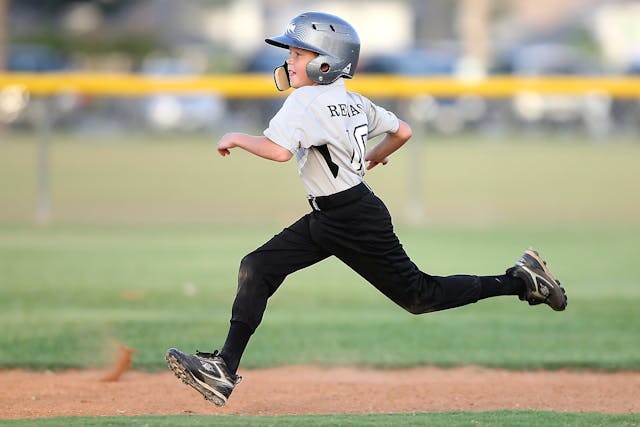- Prioritize your child’s safety with proper warm-up routines and gradual intensity increase.
- Invest in quality sports equipment that fits well and includes necessary protective gear.
- Teach correct technique through coaching, rest, and recovery to prevent overuse injuries.
- Support your child’s performance with hydration, balanced nutrition, and healthy snack choices.
- Foster open communication to identify and address potential risks and injuries promptly.
Sports are an excellent way for children to stay active, build friendships, and learn essential life skills such as teamwork and discipline. However, along with the numerous benefits of sports participation come inherent risks of injury. As parents, it’s crucial to prioritize our children’s safety while they engage in sports activities. This article will discuss five effective ways to keep your child safe while playing sports, ensuring they can enjoy the game while minimizing the risk of injury.
1. Proper Warm-up and Stretching Techniques:
Before diving into any physical activity, it’s essential for children to prepare their bodies adequately. Proper warm-up exercises help increase blood flow to the muscles, making them more flexible and less prone to injury. Here are two key practices to incorporate into your child’s warm-up routine:
Dynamic Stretching:
Encourage your child to engage in dynamic stretching exercises that mimic the movements they’ll perform during the sport. This can include leg swings, arm circles, and lunges. Dynamic stretching helps improve flexibility and range of motion, reducing the risk of strains and sprains.
Gradual Intensity Increase:
Ensure that your child gradually increases the intensity of their warm-up to prepare their cardiovascular system for the demands of the sport. Starting with light jogging or brisk walking and gradually increasing the pace can help prevent sudden exertion injuries.
2.  :
:
The right sports equipment and gear are essential for both performance and safety. Investing in quality gear can significantly reduce the risk of injuries. Here are two key aspects to consider when selecting sports equipment for your child:
Appropriate Fit:
Ensure that your child’s equipment, including helmets, pads, and footwear, fits properly. Ill-fitting gear can impair movement and increase the likelihood of injury. Regularly check and replace equipment as your child grows to maintain a proper fit.
Protective Gear:
Depending on the sport, certain protective gear such as mouthguards, shin guards, and goggles may be necessary to prevent injuries. Consult with coaches or sports professionals to determine the appropriate gear for your child’s chosen sport.
3. Emphasize Proper Technique:
Proper technique is fundamental in preventing sports-related injuries. Teaching your child the correct form and execution of movements can significantly reduce the risk of accidents. Here are two key strategies to emphasize proper technique:
Coaching and Instruction:
Enroll your child in sports programs or clubs where they can receive proper coaching and instruction from qualified professionals. Coaches can provide valuable guidance on correct techniques and offer feedback to help your child improve their skills safely.
Encourage Rest and Recovery:
Overtraining and fatigue can lead to poor technique and increase the risk of injury. Encourage your child to listen to their body and take breaks when needed. Adequate rest and recovery periods are essential for maintaining proper form and preventing overuse injuries.
4. Stay Hydrated and Nourished:
Proper hydration and nutrition play a crucial role in supporting your child’s overall health and performance on the field. Dehydration and inadequate nutrition can impair physical and cognitive function, increasing the risk of accidents and injuries. Here are two key strategies to ensure your child stays hydrated and nourished:
Hydration Guidelines:
Provide your child with plenty of water before, during, and after sports activities, especially in hot or humid conditions. Encourage them to drink water regularly to prevent dehydration, which can lead to muscle cramps, fatigue, and heat-related illnesses.
Balanced Diet:
Ensure that your child consumes a balanced diet rich in carbohydrates, protein, fruits, and vegetables to fuel their active lifestyle. Avoid sugary snacks and fast food, which can cause energy crashes and hinder performance.
5. Foster Open Communication:
Encouraging open communication with your child about their sports experiences is essential for identifying potential risks and addressing concerns promptly. Here are two ways to foster open communication:
Regular Check-ins:
Take the time to talk to your child about their sports participation regularly. Ask about any discomfort or injuries they may be experiencing and listen attentively to their concerns. Creating a supportive environment where your child feels comfortable discussing their experiences can help prevent injuries from escalating.
Educate on Injury Signs:
Teach your child to recognize the signs of common sports injuries, such as sprains, strains, and concussions. Empowering them with knowledge about injury symptoms can help them take appropriate action if they experience discomfort during sports activities. Once they feel something serious, encourage them to seek professional sports injury treatment.
Ensuring your child’s safety while playing sports requires a proactive approach that encompasses proper preparation, equipment, technique, hydration, nutrition, and communication. By implementing these five strategies, you can help minimize the risk of sports-related injuries and create a supportive environment where your child can thrive athletically and enjoy the numerous benefits of sports participation. Remember, don’t hesitate to seek expert advice when necessary. With the right precautions in place, your child can pursue their passion for sports safely and confidently.

